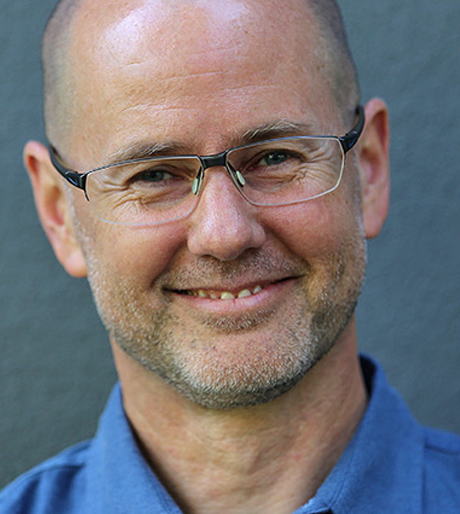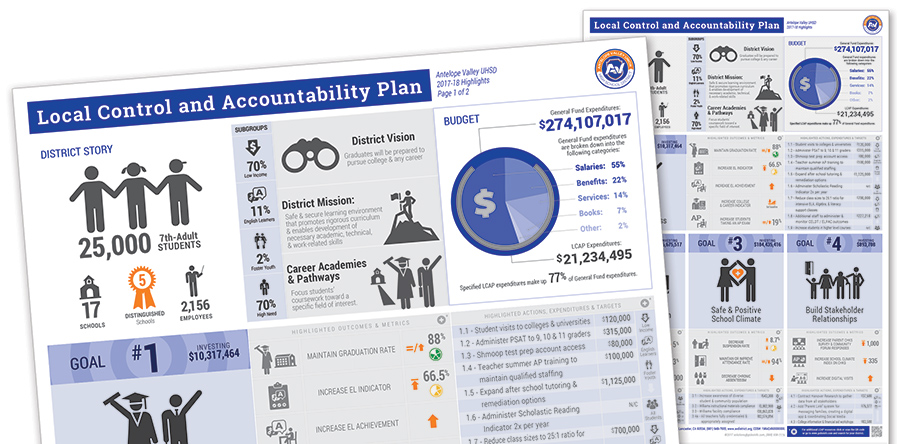
from the field
By Randall Putz
Is your district engaging?
our years ago, in a particularly long board meeting, I recall reviewing the first draft of our first Local Control and Accountability Plan, and thinking: “We’re supposed to engage our stakeholders with this?” If I wasn’t excited to read (what would turn out to be) a “svelte” 50-page document chock-full of acronyms and education-eze, I knew parents and employees wouldn’t be either.
I also recall the sting of our recently failed bond measure, and the nagging feeling that the few-month outreach effort to convince the community to invest in better schools was too little, too late.
I focused my frustration on a solution: the original LCAP Infographic. I donated it to my district and soon had superintendents around the state asking if I could help them with their own version of this tool, which helped better communicate LCAP goals and progress to the community. Fast forward to today, and we’ve helped close to 100 school districts and county offices of education across California better engage their constituents with hundreds of LCAP Infographics. This work, which requires deep distillation and familiarity with each LCAP, has given us a unique perspective on district LCAP content, and perhaps more importantly, LCAP engagement.
Ask any good teacher about effective learning and they will tell you it begins with good engagement. Similarly at the district level, desired outcomes such as increased performance, higher satisfaction and strengthened collaboration all begin with the same good engagement. But how do you know how well your district is engaging? And what can districts do to improve engagement?
To measure existing engagement efforts, consider the quantity and quality of specific LCAP-engagement activities. Are you revealing your LCAP only at board meetings, or are they freely distributed at school sites and proactively emailed to parents? How often do you have LCAP meetings? Are these meetings held only when it’s time for approval, or regularly throughout the year? Where are the meetings? Only at the district office, or out in the community and at schools? Do you provide meeting incentives like free food and childcare? Is LCAP interaction simply one-way? Or is it two-way, inclusionary, with probing need analysis? Do you make stakeholders read your lengthy LCAP document, or do you provide summarizing and engaging infographics and videos? Is the resulting stakeholder interest level passive and non-responsive, or active and enthusiastic? Do you acknowledge LCAP feedback and communicate implementation and progress? (See the Engagement Spectrum in the Stakeholder Engagement Imperative Infographic.)

To improve engagement levels, consider two real world examples from districts that have embraced high levels of engagement and reaped the rewards. “One of our explicit district goals is to engage students, parents, employees and community members in districtwide and community-specific decisions,” Capistrano Unified School District Superintendent Kirsten Vital said. “The LCAP stakeholder engagement process is one of the ways our district can accomplish this goal. Sharing data, progress and student outcomes has helped parents, staff and students better understand our areas of focus, strategies and actions. We are fortunate because we have actively involved parents, employees and students [and] lots of task forces, such as the Parent-PTA Council, a Teachers Council, English learner and special education groups, a facilities forum and an Associated Student Body Executive Council where high school students meet with the superintendent. It is really a kind of culture to support this engagement.”
Since reviewing and understanding the 70-page LCAP document can be a challenge, Vital added that infographic tools are very helpful.
Capistrano USD also draws an astute distinction between engagement and “meaningful engagement,” focusing on the depth and quality of the effort, not just the breadth. “Each stakeholder has their own ideas on how to improve programs,” said Vital. “And it is important to allow each person the opportunity to give input on what they feel the district is doing well, on what can be improved and on what is meaningful to them personally.”
A focused outreach effort has helped Antelope Valley Union High School District increase its stakeholder engagement by almost 10 times, from a few thousand in 2015–16 to more than 31,000 in 2016–17.
“We have three big seasons where we get a ton of feedback from our stakeholders,” said Joe Kelly, Ph.D., Antelope Valley UHSD’s director of school improvement. “In the fall, we conduct the Healthy Kids Survey and get feedback from students, parents and staff about the culture and conditions of our schools. In the winter, we conduct community forums. This year, we’ve actually added a second Back to School Night. We view this as an opportunity to get feedback from the community halfway through the year to make sure we are delivering on our promises. Finally, in the early spring we conduct a final survey with staff, students and leadership to triangulate the feedback.”

One of our explicit district goals is to engage students, parents, employees and community members in district-wide and community-specific decisions
Like Capistrano USD, Antelope Valley UHSD focuses on meaningful engagement and finds that visualization tools help communicate a complicated LCAP to the community. “We use several visual tools when communicating with our stakeholders,” said Kelly. “These tools include — but aren’t limited to — our website, our app, videos and infographics. Our stakeholders continue to give us high grades in regards to our methods of communication so we continue to use them. The best feedback we get is that these tools communicate information that is important to them in a simple and meaningful way.”
The impact of Antelope Valley’s robust engagement is significant. “Our academics are better than they have ever been. Our California Dashboard indicators have increased and our graduation rate and EL progress are green,” said Kelly. “And when you take into consideration the thoughts, opinions and desires of our community, people feel like they are being heard, and it avoids problems down the line.”
Antelope Valley UHSD Superintendent David Vierra, Ph. D., is also committed to incorporating community feedback into the LCAP. “Engaging stakeholders is probably the single most effective way to impact student achievement and to nurture a positive culture at our schools,” he said. “The LCFF [Local Control Funding Formula] has a minimum threshold for us in terms of engaging our stakeholders, but we try to go above and beyond each year in making sure that our stakeholders know that their feedback is important and makes an impact on how we do business.”
California’s groundbreaking LCFF and resulting LCAP is unique in that it requires all local educational agencies to actually consider stakeholder input, plan how to spend resources and then regularly report on the progress made. This mandated process is really just a cleverly disguised opportunity to do what any high-performing organization already knows is vital: engage stakeholders. The support of these parents, students, teachers and community stakeholders is critical to our schools’, and ultimately to our students’, success. A well-engaged educational community is the foundation upon which a strong society stands.
This importance, along with my direct experience and observation of district engagement across the state, has pushed me to label this opportunity as the “Stakeholder Engagement Imperative,” and even go so far as to suggest LEAs must “engage or perish.” Perhaps this is too dramatic. But perhaps not when you consider all the challenges that threaten public education, including inconsistent and inadequate funding, vouchers, privatization and deficient online academies. Who ultimately controls the resources that support public education? Your stakeholders. Engage them or perish.
Randall Putz is a former Bear Valley Unified School District trustee and currently serves as Mayor Pro Tem for the City of Big Bear Lake. He is the founder of Gobo LLC, which provides planning and engagement tools for education, government and nonprofit organizations. To learn more, visit www.goboinfo.com.